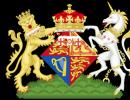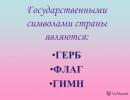Peptide bonds formation structure properties. The structure of the peptide group. Characterization of the peptide bond
Amino acids are able to connect with each other by bonds called peptide bonds, thus forming a polymer molecule. If the number of amino acids does not exceed 10, then the new compound is called peptide; if from 10 to 40 amino acids - polypeptide if more than 40 amino acids - protein.
A peptide bond is a bond between the α-carboxyl group of one amino acid and the α-amino group of another amino acid.
Peptide bond formation
If it is necessary to name the peptide, the suffix "-il" is added to all amino acid names, only the last amino acid retains its name unchanged. For example, Alan silt-ser silt-tryptophan en or γ-glutamine silt-cysteine silt-glitz And n (otherwise called glutathione).
The properties of a peptide bond include:
1. Coplanarity
All atoms in the peptide group are in the same plane, while the "H" and "O" atoms are located on opposite sides of the peptide bond.

2.Trans position of substituents
Amino acid radicals with respect to the peptide axis C-N-bonds are on "different" sides, in trans-position.

3. Two equivalent forms
The peptide bond is in the keto form and the enol form.

4. Ability to form hydrogen bonds.
The oxygen and hydrogen atoms included in the peptide group have the ability to form hydrogen bonds with the oxygen and hydrogen atoms of other peptide groups.

5. The peptide bond has a partially double bond character.
The length of the peptide bond is less than that of a single bond, it is a rigid structure and rotation around it is difficult. But since, in addition to the peptide, there are other bonds in the protein, the chain of amino acids is able to rotate around the main axis, which gives proteins a different conformation (spatial arrangement of atoms).
A peptide bond is a strong connection between fragments of two amino acids, which underlies the formation of linear structures of proteins and peptides. In such molecules, each amino acid (with the exception of the terminal ones) is connected to the previous and subsequent ones.
Depending on the number of links, peptide bonds can create dipeptides (consist of two amino acids), tripeptides (of three), tetrapeptides, pentapeptides, etc. Short chains (from 10 to 50 monomers) are called oligopeptides, and long chains are called polypeptides and proteins ( mol weight more than 10 thousand Yes).
Characterization of the peptide bond
A peptide bond is a covalent chemical compound between the first carbon atom of one amino acid and the nitrogen atom of another, resulting from the interaction of the alpha carboxyl group (COOH) with the alpha amino group (NH 2). In this case, the nucleophilic substitution of OH-hydroxyl for an amino group occurs, from which hydrogen is separated. As a result, a single C-N connection and a water molecule.
Since the loss of some components (OH group and hydrogen atom) occurs during the reaction, peptide units are no longer called amino acids, but amino acid residues. Due to the fact that the latter contain 2 carbon atoms, the peptide chain is alternating C-C and C-N bonds that form the peptide backbone. On the sides of it are amino acid radicals. The distance between carbon and nitrogen atoms varies from 0.132 to 0.127 nm, which indicates an indefinite bond.
The peptide bond is a very strong form chemical interaction. Under standard biochemical conditions corresponding to the cellular environment, it does not undergo self-destruction.
The peptide bond of proteins and peptides is characterized by the property of coplanarity, since all the atoms involved in its formation (C, N, O and H) are located in the same plane. This phenomenon is explained by the rigidity (i.e., the impossibility of rotation of the elements around the bond) resulting from resonance stabilization. Within the amino acid chain, between the planes of the peptide groups, there are α-carbon atoms associated with radicals.

Configuration types
Depending on the position of the alpha carbon atoms relative to the peptide bond, the latter can have 2 configurations:
- "cis" (located on one side);
- "trans" (located on different sides).
The trans form is characterized by greater stability. Sometimes configurations are characterized by the arrangement of radicals, which does not change the essence, since they are associated with alpha carbon atoms.
Resonance phenomenon
The peculiarity of the peptide bond is that it is 40% double and can be found in three forms:
- Ketolic (0.132 nm) - C-N-bond is stabilized and completely single.
- Transitional or mesomeric - an intermediate form, has a partially indefinite character.
- Enol (0.127 nm) - the peptide bond becomes completely double, and C-O connection- completely single. In this case, the oxygen acquires a partially negative charge, and the hydrogen atom acquires a partially positive charge.

This feature is called the resonance effect and is explained by the delocalization of the covalent bond between the carbon and nitrogen atom. In this case, the hybrid sp 2 orbitals form an electron cloud that propagates to the oxygen atom.
Peptide bond formation
Peptide bond formation is a typical polycondensation reaction that is thermodynamically unfavorable. Under natural conditions, the equilibrium is shifted towards free amino acids, therefore, for the implementation of the synthesis, a catalyst is required that activates or modifies the carboxyl group for easier leaving of the hydroxyl group.
In a living cell, the formation of a peptide bond occurs in the protein-synthesizing center, where specific enzymes act as a catalyst, working with the expenditure of energy from macroergic bonds.
Content:
The benefits of amino acids in strength training. Four groups reflecting the formation of the structure of a protein molecule.
A protein is a polymer molecule in which there is a group of monomers (that is, small elements) - amino acids. The properties and action of the latter depend on which amino acids form the composition of the protein, as well as on their alternation. In total, twenty amino acids can be found in the human body, which are found in various combinations in a protein of different design. Conventionally, all components of a protein molecule can be considered as letters of the alphabet, on which a certain amount of information is fixed. Only a word can testify to some object or action, and a set of amino acids can indicate the function of a particular protein, its capabilities and work efficiency.
About the benefits
Hundreds of articles and books have been written about the features and benefits of such useful elements. Why not, because they really form our body, are the constituent elements of the protein and help develop in all respects. The main properties include:
- acceleration of protein synthesis. The presence in the body of a full complex of amino acids contributes to the stimulation of insulin production and activation of mTor. Together, these mechanisms help trigger muscle mass growth;
- energy source. Such components pass through a different metabolic pathway and differ in their function from carbohydrates. As a result, the body receives large amounts of energy and is filled with an amino acid pool. Bottom line - muscles grow much faster;
- suppression of catabolic processes. With their help, you can forever forget what the destruction of your own muscles is, because the body will always have material for building new protein molecules;
- fat reduction. A useful function is to help in the formation of leptin, which contributes to the most rapid burning of body fat. All this allows you to achieve maximum effect.
The useful actions of amino acid groups can also include participation in the exchange of nitrogen in the body, restoration of damaged tissue areas, ensuring metabolic processes, full muscle recovery, and lowering blood sugar levels. In addition, beneficial actions include stimulating growth hormone, increasing endurance, providing the body with the necessary amount of energy, normalizing metabolic processes, stimulating the immune system, normalizing the digestive process, protecting against radiation, and so on.
Structure
Chemists distinguish four main groups that reflect the essence of the structural formation of the molecule, a component that is so necessary and important for the human body. There are only four such groups, and each of them has its own characteristics of formation - primary, secondary, tertiary and quaternary. Let's consider these nuances in more detail:

Conclusion
Here we briefly examined how amino acids form an element that is so necessary for a person.
Amino acids are able to connect with each other by bonds called peptide bonds, thus forming a polymer molecule. If the number of amino acids does not exceed 10, then the new compound is called peptide; if from 10 to 40 amino acids - polypeptide if more than 40 amino acids - protein.
A peptide bond is a bond between the α-carboxyl group of one amino acid and the α-amino group of another amino acid.
Peptide bond formation
If it is necessary to name the peptide, the suffix "-il" is added to all amino acid names, only the last amino acid retains its name unchanged. For example, Alan silt-ser silt-tryptophan en or γ-glutamine silt-cysteine silt-glitz And n (otherwise called glutathione).
The properties of a peptide bond include:
1. Coplanarity
All atoms in the peptide group are in the same plane, while the "H" and "O" atoms are located on opposite sides of the peptide bond.

2.Trans position of substituents
Amino acid radicals with respect to the peptide axis C-N-bonds are on "different" sides, in trans-position.

3. Two equivalent forms
The peptide bond is in the keto form and the enol form.

4. Ability to form hydrogen bonds.
The oxygen and hydrogen atoms included in the peptide group have the ability to form hydrogen bonds with the oxygen and hydrogen atoms of other peptide groups.

5. The peptide bond has a partially double bond character.
The length of the peptide bond is less than that of a single bond, it is a rigid structure and rotation around it is difficult. But since, in addition to the peptide, there are other bonds in the protein, the chain of amino acids is able to rotate around the main axis, which gives proteins a different conformation (spatial arrangement of atoms).
Amino acids in the polypeptide chain are linked by an amide bond, which is formed between the α-carboxyl group of one and the α-amino group of the next amino acid (Fig. 1). The covalent bond formed between amino acids is called peptide bond. The oxygen and hydrogen atoms of the peptide group in this case occupy a transposition.
Rice. 1. Scheme of peptide bond formation.In each protein or peptide, one can distinguish: N-terminus a protein or peptide that has a free a-amino group (-NH2);
S-endhaving a free carboxyl group (-COOH);
Peptide backboneproteins, consisting of repeating fragments: -NH-CH-CO-; Amino acid radicals(side chains) (R1 And R2)- variable groups.
The abbreviated notation of the polypeptide chain, as well as protein synthesis in cells, necessarily begins at the N-terminus and ends at the C-terminus:
The names of the amino acids included in the peptide and forming a peptide bond have the endings -ill. For example, the tripeptide above is called threonyl-histidyl-proline.
The only variable part that distinguishes one protein from all the others is the combination of radicals (side chains) of the amino acids that make up it. Thus, the individual properties and functions of a protein are determined by the structure and sequence of amino acids in the polypeptide chain.
Polypeptide chains of various body proteins can include from a few amino acids to hundreds and thousands of amino acid residues. Their molecular mass(mol. mass) also varies widely. So, the hormone vasopressin consists of 9 amino acids, they say. mass 1070 kD; insulin - from 51 amino acids (in 2 chains), they say. mass 5733 kD; lysozyme - from 129 amino acids (1 chain), they say. mass 13 930 kD; hemoglobin - from 574 amino acids (4 chains), they say. mass 64,500 kD; collagen (tropocollagen) - from about 1000 amino acids (3 chains), they say. mass ~130,000 kD.
The properties and function of a protein depend on the structure and order of alternation of amino acids in the chain, a change in the amino acid composition can greatly change them. So, 2 hormones of the posterior pituitary gland - oxytocin and vasopressin - are nanopeptides and differ in 2 of 9 amino acids (in positions 3 and 8):

The main biological effect of oxytocin is to stimulate the contraction of the smooth muscles of the uterus during childbirth, and vasopressin causes water reabsorption in the renal tubules (antidiuretic hormone) and has a vasoconstrictive property. Thus, despite the great structural similarity, the physiological activity of these peptides and the target tissue they act on differ, i.e. replacement of only 2 of 9 amino acids causes a significant change in the function of the peptide.
Sometimes a very small change in the structure of a large protein causes suppression of its activity. So, the enzyme alcohol dehydrogenase, which breaks down ethanol in the human liver, consists of 500 amino acids (in 4 chains). Its activity among the inhabitants of the Asian region (Japan, China, etc.) is much lower than among the inhabitants of Europe. This is due to the fact that in the polypeptide chain of the enzyme, glutamic acid is replaced by lysine at position 487.
Interactions between amino acid radicals play great importance in the stabilization of the spatial structure of proteins, 4 types can be distinguished chemical bonds: hydrophobic, hydrogen, ionic, disulfide.
Hydrophobic bonds arise between nonpolar hydrophobic radicals (Fig. 2). They play a leading role in the formation of the tertiary structure of the protein molecule.

Rice. 2. Hydrophobic interactions between radicals
Hydrogen bonds- are formed between polar (hydrophilic) uncharged groups of radicals having a mobile hydrogen atom, and groups with an electronegative atom (-O or -N-) (Fig. 3).
Ionic bonds are formed between polar (hydrophilic) ionic radicals having oppositely charged groups (Fig. 4).

Rice. 3. Hydrogen bonds between amino acid radicals

Rice. 4. Ionic bond between lysine and aspartic acid radicals (A) and examples of ionic interactions (B)
disulfide bond- covalent, formed by two sulfhydryl (thiol) groups of cysteine radicals located in different places of the polypeptide chain (Fig. 5). It is found in proteins such as insulin, the insulin receptor, immunoglobulins, etc.
Disulfide bonds stabilize the spatial structure of one polypeptide chain or link 2 chains together (for example, chains A and B of the insulin hormone) (Fig. 6).

Rice. 5. Formation of a disulfide bond.

Rice. 6. Disulfide bonds in the insulin molecule. Disulfide bonds: between cysteine residues of the same chain A(a), between chains A And IN(b). Numbers - position of amino acids in polypeptide chains.





